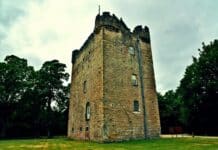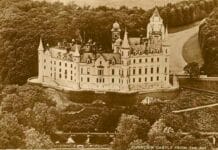The gory ghost of a woman sliced in two haunts a Scottish castle in Perthshire, MJ STEEL COLLINS reports
Located in Glen Lyon, Perthshire, Meggernie Castle boasts a ghostly legend that’s strange even by Scottish standards.
The castle dates back to around about 1585, when it was built by ‘Mad’ Colin Campbell as a tower house, and later expanded.
Later, the castle was purchased by the Atholl Murrays and then passed to the Menzies of Culdares.
The legend giving rise to the ghost relates to one of the Menzies, who was said to have been extremely jealous of his beautiful wife.
Though, he had no proof of her committing any infidelity, one day, the Laird lost his temper and beat her to death.
Menzies then covered his tracks by chopping the dead woman’s body in two, hiding the upper half beneath the floor of a cupboard adjoining two rooms in the tower, and the lower half, he quietly disposed of in the graveyard.
Then he went on a lengthy trip around Europe; on his return, he claimed his wife had drowned during the trip. Menzies, it is claimed, then attempted to remove the upper part of the body for burial in the graveyard, but failed to complete his mission.
He was found dead the following day, apparently murdered, some say by the vengeful ghost of his wife. As it was, there were rumours that Meggernie was haunted by the upper half of a female ghost, whilst the lower half walked the graveyard.
Several experiences have been recorded of the ghost, which is given in greatest detail in Alasdair Alpin MacGregor’s Phantom Footsteps.
Perhaps the most often told are the experiences in 1862 of E J Simons and Beaumont Fetherstone, two friends who were given rooms in the Tower when staying at Meggernie.
The rooms were next to each other, sharing a strangely blocked up cupboard. One night, Simons was awoken by a burning sensation, as if he had been kissed on the cheek, though he couldn’t see any mark when checking in the mirror.
He saw the upper half of a woman float towards the blocked off cupboard.
Meanwhile, Fetherstone awoke to the sight of the woman again floating towards the blocked cupboard, and his room was bathed in a pink light. On waking up, both men shouted through to each other they had strange experiences during the night.
They immediately decided not to tell each other what happened in case they influenced one another’s accounts. Instead they separately told their host, Herbert Wood, what happened. Wood took notes; it turned out both experiences were quite similar.
They were prevented from sharing their experiences at breakfast by Mrs Wood for fear of scaring off the servants. The ghost had recently been seen several times roaming the halls of the house and outside in the grounds and nearby graveyard.
A week or so later, Simons encountered the ghost again whilst writing letters late at night in the library. Despite the roaring blaze in the grate, the room became incredibly cold, and Simons seized with an unaccountable fear. His attention was drawn to the heavy library door, which began to open, and he witnessed the upper half of the female ghost drift by and head down the corridor.
Gathering up his courage, he decided to make the long journey down the corridor and head up to his room. Heading down the corridor, he saw in the passage’s only window, the sad face of the ghost, which he described as beautiful. A strange epilogue occurred a year later, when Fetherstone met a woman in a hotel, who had also encountered the ghost.
Further experiences are recorded in numerous books on Scottish ghosts. Terence Whitaker writes in Scotland’s Ghosts and Apparitions that at the turn of the 20th century, a house maid ran terrified to her mistress after seeing the ghost. She had encountered the bloodied lower part of the apparition in the corridor leading up to the tower, the section normally seen outside in the graveyard.
Peter Underwood, in Gazetteer of Scottish Ghosts, mentions that the wife of a General Kinloch Grant awoke one night in a Tower bedroom to find the ghost leaning over her, but wasn’t afraid. Mrs Kinloch Grant apparently enjoyed spending time in the graveyard, which she found peaceful, and didn’t understand why it had such a bad reputation that locals avoided it at night.
In 1928, a doctor had been called out to Meggernie late at night, and was offered a room for the night as his home was quite a long distance away. He accepted, and was given a room in the Tower. He woke up during the night, by the sound of footsteps in the corridor approaching his door.
The anticipating knock on the door wasn’t forthcoming, but someone seemed to be in the room. Looking up, he saw the upper section of the ghost floating round the walls, near the ceiling, before disappearing. He mentioned it at breakfast, asking why he had been put in the haunted room; he had actually been put in the room below the haunted room. The floors had been raised since 1862, and the ghost was merely following the original level.
The tale has a twist with the story that during renovations in the early twentieth century, the upper section of a human skeleton was found in the floor beneath the cupboard adjoining the bedrooms in the tower. The remains were reburied in the graveyard, but it’s said the ghost still walks.







